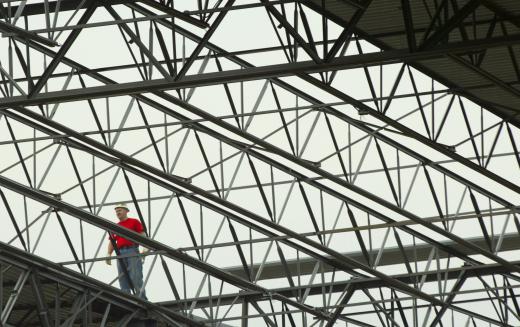What Is a Girder Truss?
A truss is a roof or floor support structure built from a connected series of box- or triangle-shaped elements to distribute load to a building's walls or foundation. These are often pre-fabricated and sent to a construction site. A girder truss is designed to support other secondary roof supports. Buildings constructed in L or T shapes use girder truss systems where the roof changes direction. Using these structures in roof design eliminates the need for a load-bearing wall below, resulting in open floor plans.
Hip roof designs, where the roof on each side of the building slopes up to the top, incorporate girder structural members where the hip roof elements connect to the main roof. The girder truss on each end of the main roof must support the weight of the hip roof element on each side. Hip roofs can provide structural strength advantages over gabled roofs in hurricane zones.

Wood is a common construction material for girder systems. The girder truss can be built by joining multiple single support elements. High-strength bolts are required to connect the elements, because the girder system will carry a much higher load than a single roof truss. A structural engineer or architect can calculate the design loads, girder size and fastener requirements to safely carry the load.
When a building roof changes direction, the second roof line intersects with the first. Cutting the roof supports or simply nailing the new roof line into the original roof supports can quickly overload the roof structure. A girder truss is installed where the second roof line begins to intersect with the first roof. The two roofs are then joined with connecting members that can safely be hung from the girder.
Improvements in construction materials have led to improved building designs. Beginning in the 1980s, engineered lumber using combinations of wood and polymer adhesives resulted in structural wood products much stronger than standard wood. These engineered systems permit wider spans without using load-bearing walls. Ceilings can be raised without adversely affecting the roof strength, since the engineered structures can carry higher loads.
Girder trusses can be integrated into other useful roof designs. Gables can be incorporated into hip roofs by lowering the side roof rafters to create small gables. These elements not only add character, they can incorporate vents to reduce attic heat loads without sacrificing strength. For occupied spaces such as second floor rooms, end gables can incorporate windows without having to add reinforcing walls.
Designs for girder trusses do not have to resemble standard sloped roofs. Flat roofs for industrial or warehouse operations can use level girder supports. When the building changes direction, addition of an engineered support system at the intersection can result in an open room design favorable to commercial or warehouse operations.
AS FEATURED ON:
AS FEATURED ON:











Discussion Comments
I hate to shoot you both down but the article says that girder trusses don't have to be sloped. They can be used for a flat ceiling, like a factory with level girder supports.
@ Sun Seal
Hey, my wife and I are doing the same thing! It's a lot of work. We haven't made it to the trusses yet. With girder trusses I think there can be a slight slope. It's just not as pronounced as a traditional sloped roof. Does your roof change direction at all? You have to use a girder truss there, according to the article.
We're building a cabin and doing all of the work ourselves, the trusses were the most difficult part of the job. The cabin is two stories and we had to design a pulley system to lift them into place. In the article it says that end gables can be added without having to reinforce the walls with girder trusses. Are there different girder truss designs? I always thought that meant a flat roof which won't work for us; too much snow.
Post your comments